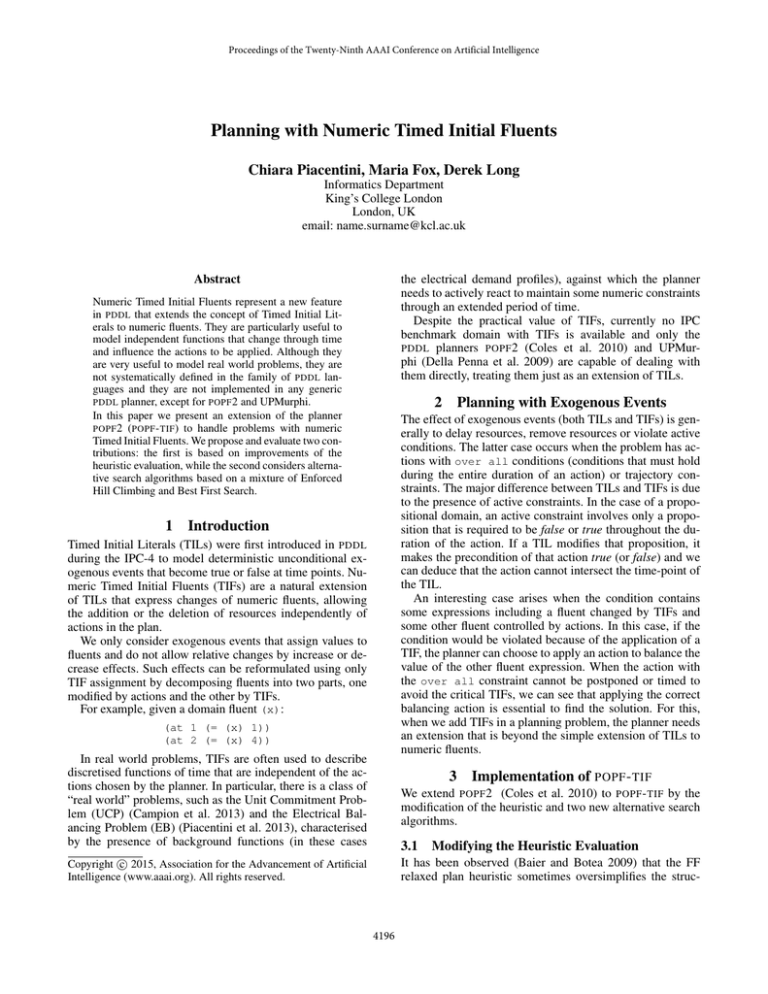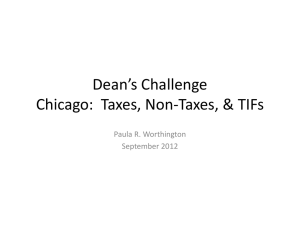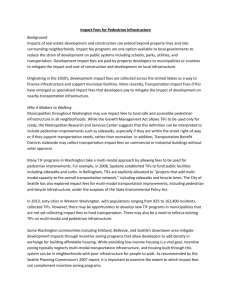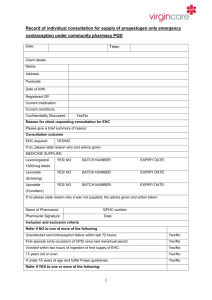
Proceedings of the Twenty-Ninth AAAI Conference on Artificial Intelligence
Planning with Numeric Timed Initial Fluents
Chiara Piacentini, Maria Fox, Derek Long
Informatics Department
King’s College London
London, UK
email: name.surname@kcl.ac.uk
Abstract
the electrical demand profiles), against which the planner
needs to actively react to maintain some numeric constraints
through an extended period of time.
Despite the practical value of TIFs, currently no IPC
benchmark domain with TIFs is available and only the
PDDL planners POPF 2 (Coles et al. 2010) and UPMurphi (Della Penna et al. 2009) are capable of dealing with
them directly, treating them just as an extension of TILs.
Numeric Timed Initial Fluents represent a new feature
in PDDL that extends the concept of Timed Initial Literals to numeric fluents. They are particularly useful to
model independent functions that change through time
and influence the actions to be applied. Although they
are very useful to model real world problems, they are
not systematically defined in the family of PDDL languages and they are not implemented in any generic
PDDL planner, except for POPF 2 and UPMurphi.
In this paper we present an extension of the planner
POPF 2 ( POPF - TIF ) to handle problems with numeric
Timed Initial Fluents. We propose and evaluate two contributions: the first is based on improvements of the
heuristic evaluation, while the second considers alternative search algorithms based on a mixture of Enforced
Hill Climbing and Best First Search.
1
2
Planning with Exogenous Events
The effect of exogenous events (both TILs and TIFs) is generally to delay resources, remove resources or violate active
conditions. The latter case occurs when the problem has actions with over all conditions (conditions that must hold
during the entire duration of an action) or trajectory constraints. The major difference between TILs and TIFs is due
to the presence of active constraints. In the case of a propositional domain, an active constraint involves only a proposition that is required to be false or true throughout the duration of the action. If a TIL modifies that proposition, it
makes the precondition of that action true (or false) and we
can deduce that the action cannot intersect the time-point of
the TIL.
An interesting case arises when the condition contains
some expressions including a fluent changed by TIFs and
some other fluent controlled by actions. In this case, if the
condition would be violated because of the application of a
TIF, the planner can choose to apply an action to balance the
value of the other fluent expression. When the action with
the over all constraint cannot be postponed or timed to
avoid the critical TIFs, we can see that applying the correct
balancing action is essential to find the solution. For this,
when we add TIFs in a planning problem, the planner needs
an extension that is beyond the simple extension of TILs to
numeric fluents.
Introduction
Timed Initial Literals (TILs) were first introduced in PDDL
during the IPC-4 to model deterministic unconditional exogenous events that become true or false at time points. Numeric Timed Initial Fluents (TIFs) are a natural extension
of TILs that express changes of numeric fluents, allowing
the addition or the deletion of resources independently of
actions in the plan.
We only consider exogenous events that assign values to
fluents and do not allow relative changes by increase or decrease effects. Such effects can be reformulated using only
TIF assignment by decomposing fluents into two parts, one
modified by actions and the other by TIFs.
For example, given a domain fluent (x):
(at 1 (= (x) 1))
(at 2 (= (x) 4))
In real world problems, TIFs are often used to describe
discretised functions of time that are independent of the actions chosen by the planner. In particular, there is a class of
“real world” problems, such as the Unit Commitment Problem (UCP) (Campion et al. 2013) and the Electrical Balancing Problem (EB) (Piacentini et al. 2013), characterised
by the presence of background functions (in these cases
3 Implementation of POPF - TIF
We extend POPF 2 (Coles et al. 2010) to POPF - TIF by the
modification of the heuristic and two new alternative search
algorithms.
3.1
Modifying the Heuristic Evaluation
It has been observed (Baier and Botea 2009) that the FF
relaxed plan heuristic sometimes oversimplifies the struc-
c 2015, Association for the Advancement of Artificial
Copyright Intelligence (www.aaai.org). All rights reserved.
4196
0.1
best=2
la=0
la=1
1
10
time
100 1000
la=2
la=3
First Mixed Search
0.1
1
10
time
best=8
la=0
la=1
100 1000
la=2
la=3
120
100
80
60
40
20
0
0.01
Second Mixed Search
# problems solved
120
100
80
60
40
20
0
0.01
# problems solved
BFS
# problems solved
# problems solved
EHC
120
100
80
60
40
20
0
0.01
0.1
best=7
la=0
la=1
1
10
time
100 1000
120
100
80
60
40
20
0
0.01
la=2
la=3
0.1
best=6
la=0
la=1
1
10
time
100 1000
la=2
la=3
Figure 1: Number of problems solved as function of execution time.
home within the user’s preferences. The temperature is
subject to weather conditions, but can be regulated by
means of electrochromic windows, that can be tinted.
- Skier domain: a skier descends along a track at constant
velocity, but the track is not always straight, so the problem for the skier is to decide when to turn left or right to
arrive to the goal without going off track.
In our evaluation we compare EHC, BFS, S1 and S2. For
each search strategy we use heuristic evaluations with a different number of lookaheads, from 0 to 10, where 0 indicates the standard heuristic evaluation. All tests used a 3.4
GHz Intel Core i7-2600 machine, limited to 30 minutes and
4 GB of memory. In Fig. 1 we plot the number of problems
solved as a function of execution time for all the domains.
The results indicate that adding more lookaheads increases
the coverage of all the four search strategies. The algorithm
most affected by the lookahead is EHC, which benefits from
the change in the heuristic mainly because the relaxed plan
graph includes a more appropriate set of helpful actions.
Overall the algorithm with more coverage is the first of the
two mixed search algorithms.
ture of a problem, resulting in an inaccuracy of the heuristic
value. A way to mitigate this is to reduce the relaxation to
gain more information. In the paper (Piacentini et al. 2013),
this idea is applied for TIFs: during the extraction of the relaxed plan, starting from the layer containing the goal, the
algorithm proceeds backwards, applying the actions needed
to achieve the goals. When a the fact layer that corresponds
to the first TIF is met, then the over all constraints of open
actions are checked for violation, because of the TIF, and, in
the case of conflict, the violated constraints are added to the
goals of the relaxed plan graph.
In our work we extend this lookahead mechanism allowing more TIFs to be considered in the heuristic evaluation.
Domains involving TIFs often have a rich temporal structure, and one lookahead might not be adequate.
3.2
Additional Search Algorithms
We want to take advantage of the local search EHC benefits, but decrease the possibility of failure. For this reason
we use an algorithm that allows passage from the EHC into
BFS, exploiting the information that EHC already acquired.
In addition, we want to be able to switch back to the EHC
when a “safe” state is reached.
We propose two different search algorithms based on the
mixture of EHC and BFS, that we call S1 and S2 . The difference between them is in how the states are selected from
a backup queue. In the first case (S1) we resort to the BFS
from the last backup states of the queue and continue until
we find a solution or a restoring state. In the latter case we
switch back to the EHC. If the BFS fails we can invoke a
new BFS from the latest state in the backup queue. In the
second algorithm (S2), when the BFS is activated, it starts
with the entire backup queue, so it begins with some states
explored. Also in this case, when a restoring state is found
we switch back to the EHC.
4
References
Baier, J. A., and Botea, A. 2009. Improving Planning Performance Using Low-Conflict Relaxed Plans. In Proc. Int.
Conf. Automated Planning and Scheduling (ICAPS).
Campion, J.; Dent, C.; Fox, M.; Long, D.; and Magazzeni,
D. 2013. Challenge: Modelling Unit Commitment as a Planning Problem. In Proc. Int. Conf. Automated Planning and
Scheduling (ICAPS).
Coles, A. J.; Coles, A.; Fox, M.; and Long, D. 2010.
Forward-Chaining Partial-Order Planning. In Proc. Int.
Conf. Automated Planning and Scheduling (ICAPS).
Della Penna, G.; Magazzeni, D.; Mercorio, F.; and Intrigila, B. 2009. UPMurphi: A Tool for Universal Planning on
PDDL+ Problems. In Proc. Int. Conf. Automated Planning
and Scheduling (ICAPS).
Ono, M.; Graybill, W.; and Williams, B. C. 2012. Risksensitive plan execution for connected sustainable home. In
BuildSys ’12 Proc. of ACM Workshop on Embedded Sensing
Systems for Energy-Efficiency in Buildings. ACM Press.
Piacentini, C.; Alimisis, V.; Fox, M.; and Long, D. 2013.
Combining a Temporal Planner with an External Solver for
the Power Balancing Problem in an Electricity Network.
In Proc. Int. Conf. Automated Planning and Scheduling
(ICAPS).
Experimental Evaluation
We now present results of the planner POPF - TIF with the
following domains (30 problems each domain):
- Unit Commitment Problem (UCP);
- Rover domain: a variant of the numeric rover domain in
which the rover is equipped with a solar panel that gives
energy to the rover according to the exposure to the sun.
- Temperature domain: a PDDL version of the problem
presented in (Ono, Graybill, and Williams 2012), where
the objective is to maintain the temperature of a smart
4197







